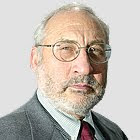
Quantitative easing may seem an answer to the US's problems, but any benefits would likely be offset by the costs
Joseph Stiglitz
guardian.co.uk, Thursday 7 October 2010
"With interest rates near zero, the US Federal Reserve and other central banks are struggling to remain relevant. The last arrow in their quiver is quantitative easing (QE), and it is likely to be almost as ineffective in reviving the US economy as anything else the Fed has tried in recent years. Worse, QE is likely to cost taxpayers a bundle, while impairing the Fed's effectiveness for years to come.
John Maynard Keynes argued that monetary policy was ineffective during the great depression. Central banks are better at restraining markets' irrational exuberance in a bubble – restricting the availability of credit or raising interest rates to rein in the economy – than at promoting investment in a recession. That is why good monetary policy aims to prevent bubbles from arising.
But the Fed, captured for more than two decades by market fundamentalists and Wall Street interests, not only failed to impose restraints, but acted as cheerleader. And, having played a central role in creating the current mess, it is now trying to regain face....."
Joseph Stiglitz
guardian.co.uk, Thursday 7 October 2010
"With interest rates near zero, the US Federal Reserve and other central banks are struggling to remain relevant. The last arrow in their quiver is quantitative easing (QE), and it is likely to be almost as ineffective in reviving the US economy as anything else the Fed has tried in recent years. Worse, QE is likely to cost taxpayers a bundle, while impairing the Fed's effectiveness for years to come.
John Maynard Keynes argued that monetary policy was ineffective during the great depression. Central banks are better at restraining markets' irrational exuberance in a bubble – restricting the availability of credit or raising interest rates to rein in the economy – than at promoting investment in a recession. That is why good monetary policy aims to prevent bubbles from arising.
But the Fed, captured for more than two decades by market fundamentalists and Wall Street interests, not only failed to impose restraints, but acted as cheerleader. And, having played a central role in creating the current mess, it is now trying to regain face....."

No comments:
Post a Comment